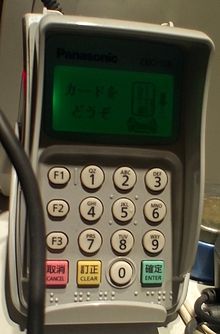Payment terminal
This article needs additional citations for verification. (April 2016) |
The examples and perspective in this article may not represent a worldwide view of the subject. (April 2016) |

A payment terminal, also known as a point of sale terminal, credit card terminal, EFTPOS terminal (or a PDQ terminal in the United Kingdom), is a device which interfaces with payment cards to make electronic funds transfers.
There are various types of terminals available to merchants, although most have the same basic purpose and functions. They allow a merchant to insert, swipe, or manually enter the required credit/debit card information, to transmit this data to the merchant service provider for authorization and finally, to transfer funds to the merchant. Most newer models not only process credit and debit cards but can also handle gift cards, cheques, and so on. The majority of card terminals transmit data over a standard telephone line or a wired or wireless Internet connection. Some also have the ability to cache transactional data to be transmitted to the gateway processor when a connection becomes available; the major drawback to this is that immediate authorization is not available at the time the card was processed, which can subsequently result in failed payments. Remote wireless terminals can transmit card data using either cellular or satellite networks.

A merchant can replace the functionality of dedicated credit card terminal hardware using a terminal application running on a PC or mobile device, such as a smartphone. They usually work with dedicated hardware readers that can transfer magnetic stripe data to the application, while there are also some that also work with smart cards (using technology such as EMV), although this is rarely seen on smartphone readers. In case the necessary hardware is unavailable, these applications usually support manual entry of the card number and other data. In addition, more and more devices are beginning to offer built-in RFID or NFC technology to accommodate contactless or mobile device payment methods, often without requiring additional external hardware.[1]
By moving to the use of card terminals to directly capture card information instead of manually entering in card details, merchants benefit from the efficiency of decreased transaction processing times. Previously, merchants could obtain lower processing costs by processing chip cards instead of Magnetic stripe cards. On the contrary, security is particularly of concern to such users: PCI DSS requirements need to be considered when using unsecured and unencrypted systems based on generic or open platforms; cardholder data security is integral to mandatory merchant PCI compliance. Several high profile breaches resulting in mass theft of cardholder data have occurred in the past due to the point of sale malware where people have accessed data stored insecurely on bespoke or custom systems operated by merchants.[2]
History
Point of sale terminals emerged in 1979, when Visa introduced a bulky electronic data capturing terminal which was the first payment terminal. In the same year credit cards were replaced to include a magnetic information stripe.[3]
In 1981 a small electronics company started in Hawaii that is now know Verifone building payment terminals. In 1983 they introduced the ZON terminal which would become the standard for modern payment terminals.
Typical features

- Key entry (for customer not present mail and telephone order)
- Tips/gratuities
- Refunds and adjustments
- Settlement (including automatic)
- Pre-authorisation
- Payments using near field communication enabled devices
- Remote initialisation and software update
- POS integration
- Semi-integrated POS
- Multi-merchant capabilities
- Pen or PIN authorization by the customer
- Surcharge function
- Secure password operation
Manufacturers

- Spire Payments
- First Data
- VeriFone (formerly Hypercom)
- Ingenico
- Dejavoo
- Exadigm
- XAC Automation Corp.
- Panasonic
See also
References
- ^ Whitney, Lance (2011-03-24). "App turns Google Nexus phone into payment tool". CNET. Retrieved March 24, 2015.
- ^ Clark, Andrew (2007-03-30). "TK Maxx hit by theft of 46m credit card details". The Guardian. Retrieved November 16, 2012.
- ^ Jamie Estep (April 12, 2006). "The History of Credit Card Terminals".
